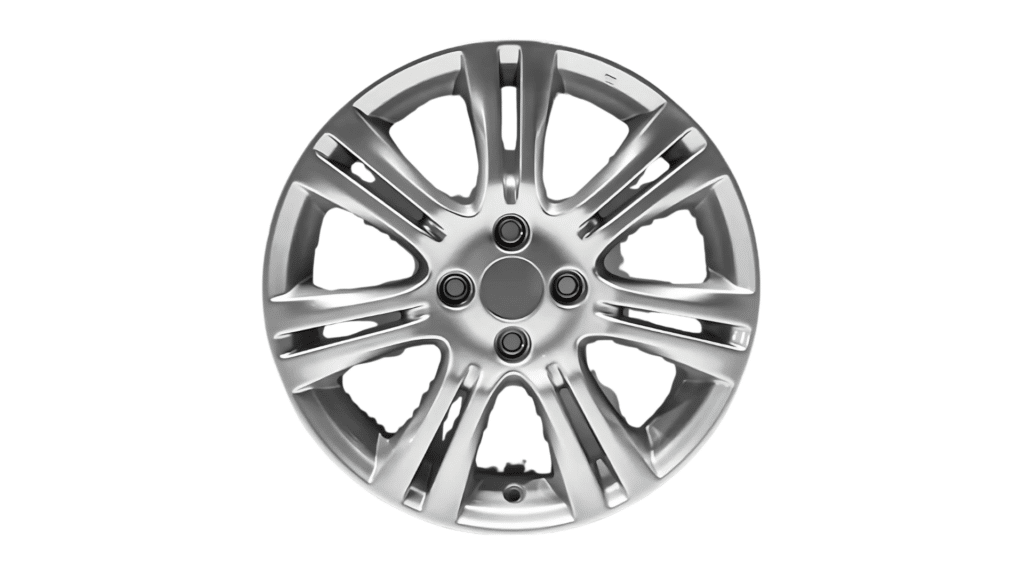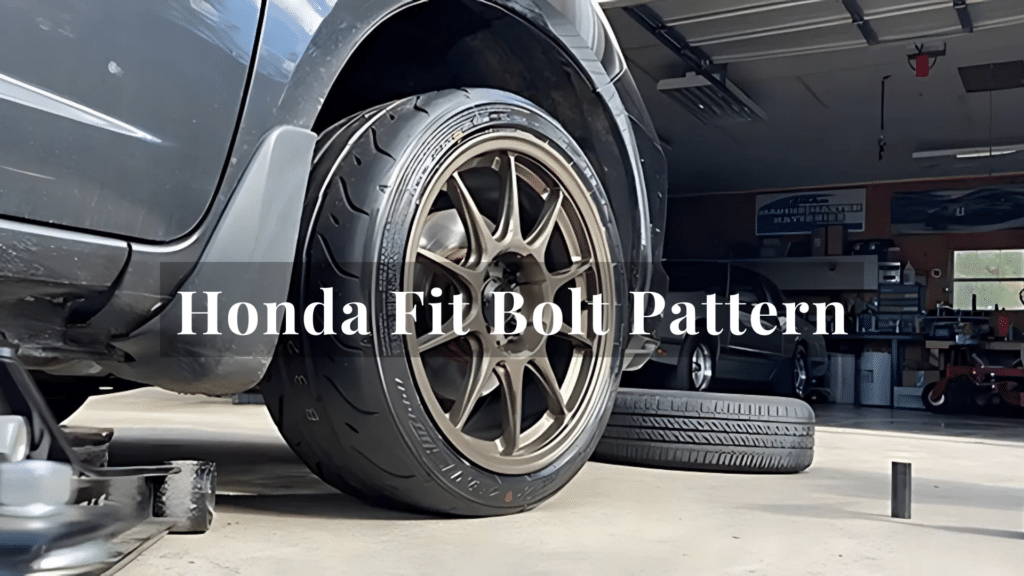When it comes to upgrading your Honda Fit’s wheels, understanding the bolt pattern is key. The bolt pattern determines how the wheels fit onto your car and ensures they are safely secured.
If you don’t get the correct pattern, the wheels might not fit properly, which could cause major issues.
In this guide, I’ll explain the Honda Fit bolt pattern, walk you through how to pick the right wheels, and offer tips on installing them.
Understanding your Honda Fit’s bolt pattern ensures that when it’s time to replace or upgrade your wheels, you’ll make the best choice for your vehicle.
Understanding the Honda Fit Bolt Pattern & Its Measurements

The Honda Fit typically uses a 4×100 bolt pattern, which means there are 4 bolts, and the distance between opposite bolts is 100 millimeters.
To measure the bolt pattern, you first count the number of bolts on the wheel. For the Honda Fit, it’s a 4-bolt pattern.
Next, measure the distance between the center of one bolt and the center of the opposite bolt. This distance is the bolt circle diameter, which for the Fit is 100mm.
Getting the right bolt pattern is essential when shopping for new wheels because it ensures the wheels will fit securely onto your car.
How to Choose Wheels for a Honda Fit Bolt Pattern?
When choosing wheels for your Honda Fit, there are several important factors to remember to ensure a proper fit and get the best performance. Here are the key things to consider:
1. Bolt Pattern: The most important factor is the bolt pattern. The Honda Fit uses a 4×100 bolt pattern. Always make sure the wheels you select have this same 4×100 bolt pattern to ensure they fit properly.
2. Wheel Size: Wheel size refers to the diameter and width of the wheel. Choosing wheels that are too large or too small could affect your vehicle’s handling, comfort, and performance.
3. Offset: Offset refers to the distance between the centerline of the wheel and the mounting surface where the wheel connects to the car. Choosing the wrong offset can cause your wheels to sit too far inward or outward.
4. Tire Compatibility: The tires you plan to use need to be compatible with your chosen wheel size. For example, if you go for larger wheels, you may need to adjust the tire size accordingly.
By considering all these factors—bolt pattern, wheel size, offset, and tire compatibility—you’ll be able to choose wheels that look great, perform well, and fit safely on your Honda Fit.
How To Install Wheels on Cars That Use the Honda Fit Bolt Pattern
Installing new wheels on your Honda Fit is a simple process, but it’s important to do it correctly to ensure safety and proper wheel alignment. Here’s a step-by-step guide to help you install your new wheels:
1. Lift the Car
- Start by safely lifting your car off the ground using a jack. Make sure to lift it from the correct jacking point (you can find this information in your car’s manual).
- Once the car is lifted, place jack stands under the car for extra safety. Never rely solely on the jack to hold the car in place—jack stands are essential for stability.
2. Remove the Old Wheels
- Using a lug wrench, loosen the lug nuts on your old wheels by turning them counterclockwise. It’s a good idea to do this while the car is still slightly on the ground, as it helps prevent the wheel from spinning.
- Once the lug nuts are loosened, fully raise the car and remove the lug nuts completely. Carefully remove the old wheels and set them aside.
3. Install the New Wheels
- Next, take the new wheels and align them with the wheel hub, making sure the holes in the wheel match up with the bolts on the car.
- Gently slide the wheel onto the hub, ensuring it fits securely and evenly. Hand-tighten the lug nuts onto the bolts to temporarily hold the wheel in place. This will prevent the wheel from moving while you tighten the nuts further.
4. Tighten the Lug Nuts
- Now, use a torque wrench to tighten the lug nuts. It’s important to pull them in a crisscross pattern (not in a circle) to ensure the wheel sits evenly on the hub.
- The proper torque setting for your Honda Fit can be found in the car’s manual. Tightening the lug nuts to the correct torque prevents the wheel from becoming loose while driving.
5. Lower the Car
- Once the lug nuts are securely tightened, carefully lower the car back to the ground using the jack. Make sure the vehicle is completely on the ground before removing the jack and jack stands.
- Give the lug nuts one last check to ensure they’re properly tightened.
Before taking your Honda Fit for a spin, check all four wheels to ensure everything is tightened correctly. A short test drive is also a good idea to ensure everything feels stable and there are no unusual noises or vibrations.
Following these steps will help you install your new wheels correctly and safely, giving your Honda Fit a fresh look or improved performance.
Benefits of the Honda Fit Bolt Pattern
The 4×100 bolt pattern used in the Honda Fit offers several advantages, making it an ideal choice for various wheel options. Here are some key benefits of this bolt pattern:
1. Wide Selection of Compatible Wheels
The 4×100 bolt pattern is one of the most common bolt patterns, not just in Honda vehicles but across many other car brands as well. This gives you access to a wide selection of wheels, from factory wheels to aftermarket options.
Whether you’re looking for alloy wheels, steel wheels, or custom designs, you’ll have plenty of options to choose from without worrying about finding a specific fit.
2. Affordable and Accessible
Because the 4×100 bolt pattern is so common, the wheels designed for this pattern are often more affordable than those for less common patterns.
Manufacturers produce a larger quantity of 4×100 wheels, which helps keep costs lower, and you’ll find many budget-friendly options. This can save you money if you’re looking for a quick upgrade without spending a lot.
3. Easy to Find Replacement Parts
In addition to being affordable, finding replacement wheels for your Honda Fit is easy.
Whether you’re replacing a damaged wheel or upgrading to a different style, the 4×100 pattern ensures that you won’t have trouble finding compatible wheels.
4. Compatibility with Other Vehicles
Another advantage of the 4×100 bolt pattern is that it’s shared by several other vehicles. This makes it easy to find used or swap wheels with other cars that use the same bolt pattern.
Some vehicles that share the 4×100 pattern with the Honda Fit include the Toyota Yaris, Mazda 2, and Mini Cooper. This means that if you own multiple vehicles or plan to buy used wheels, you’ll have more flexibility in finding a match.
5. Greater Customization Options
Because of its popularity, the 4×100 bolt pattern allows for greater customization. Many aftermarket companies design wheels with this pattern, offering a variety of styles, sizes, and finishes.
Customization doesn’t just stop at the wheels themselves – the availability of different sizes and offsets gives you more control over your car’s look and performance.
6. Improved Availability of Tires
The 4×100 bolt pattern is typically found on smaller and more compact cars, which are often paired with smaller wheels and tires.
Since these tire sizes are common, you’ll find that tires for the Honda Fit are easy to come by and relatively affordable. If you ever need new tires, you’ll have many options to choose from.
7. Easier Upgrades and Modifications
Upgrading or modifying your Honda Fit is much easier with the 4×100 bolt pattern. Many car enthusiasts prefer to customize their vehicles.
Having access to an easily available bolt pattern means you can easily swap out wheels for larger or sportier ones. You can also find low-profile or performance tires that improve handling or the overall driving experience.
The 4×100 bolt pattern in the Honda Fit offers many benefits, including cost savings, easy finding compatible wheels and tires, and the ability to customize your vehicle. If you’re upgrading your wheels for style, performance, or functionality, the 4×100 bolt pattern gives you the flexibility and variety you need to make your Honda Fit stand out.
List of Vehicles Using the Honda Fit Bolt Pattern
The Honda Fit uses a 4×100 bolt pattern shared by several other vehicles. This makes it easier to find compatible wheels for your Fit. Some cars with the same bolt pattern include:
- Honda Civic
- Toyota Yaris
- Mazda 2
- Nissan Micra
- Mini Cooper
- Subaru Impreza (Older Models)
- Hyundai Accent
- Kia Rio
- Ford Fiesta
- Chevrolet Aveo
These vehicles have similar wheel sizes, so finding compatible wheels for your Honda Fit is simple and affordable. Just make sure to check the size and offset for the perfect fit.
Common Mistakes to Avoid During Installation
To ensure a successful wheel installation, avoid these common mistakes:
- Wrong Bolt Pattern: Always check that the bolt pattern on the wheels matches the 4×100 bolt pattern of your Honda Fit.
- Incorrect Offset: Choosing the wrong offset can cause the wheels to sit improperly, affecting the car’s handling and safety.
- Not Tightening Lug Nuts Properly: Ensure the lug nuts are tightened correctly with a torque wrench to avoid any loose wheels.
- Forgetting to Check Tire Size: Make sure your new wheels match the tire size for a proper fit and better performance.
By avoiding these common mistakes, you can ensure a smooth installation and enjoy your new wheels safely and confidently.
Conclusion
The 4×100 bolt pattern is commonly used in many vehicles, which gives you plenty of options when choosing replacement or aftermarket wheels for your Honda Fit.
Whether you own one of these vehicles or are shopping for a used set of wheels, knowing that other cars use the same bolt pattern helps you expand your search.
Always make sure to double-check other specifications such as offset and wheel size to ensure a proper fit.
With the 4×100 bolt pattern, you’ll have access to a broad range of compatible wheels that can enhance the look and performance of your Honda Fit.
Frequently Asked Questions
What size wheels fit a Honda Fit?
Typically, the Honda Fit uses 15 to 16-inch wheels. However, wheel size can vary depending on the model year. Always check your car’s manual or consult a professional for the correct wheel size
Can I change the wheel size on my Honda Fit?
Yes, you can change the wheel size, but it’s important to choose a size that’s compatible with your car’s specifications.
Do I need to use specific lug nuts for Honda Fit wheels?
Yes, you should use the correct lug nuts designed for your Honda Fit’s wheels. Make sure they match the size and type of the bolts on your car to avoid damaging the wheels or wheel bolts.
How do I maintain my Honda Fit wheels?
To maintain your wheels, clean them regularly with mild soap and water, and check for any damage or wear. It’s also important to inspect the lug nuts to ensure they’re properly tightened for safety.
Can I use winter tires on my Honda Fit?
Yes, winter tires can be used on your Honda Fit. Just make sure the tire size matches the wheel size, and ensure the tires are designed for snowy or icy conditions to improve traction.

